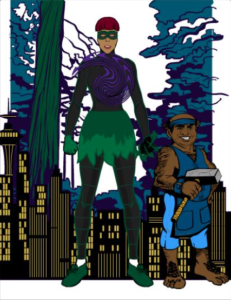Dec 18

The Science of Superheroes
Ask a class of high school students to design superheroes and what do you get? Wild Woman Paula Deen, created by tenth-grader Annie Testa, who squirts butter from her fingers and has an inner beast like the Hulk. Or White Wolf, a superhero created by ninth-grader Nathan Maggot, who has telepathic powers and super speed.
For two or three weeks each December, students at NEOMED’s Bio-Med ScienceAcademy are given the
opportunity to take fun and unusual elective classes during what’s known as Accelerated Term. Science of Superheroes was just one of the many classes offered this year.
Instructor James Martell, who teaches eleventh-grade physics at Bio-Med Academy, challenged his Science of Superheroes class to use a basic knowledge of physics and other sciences to determine if there was any scientific foot to stand on to defend their character’s superhero powers.
To make things even more interesting, the students took the superheroes they had created and matched them up on a fictitious dating site. Invitations for the weddings were created, followed by the news that the super couples would be having super babies. Here’s where the science comes in: Each pair of students decided what super traits were dominant and recessive, using Mendelian genetic inheritance probabilities. Next, they calculated the chance of their super babies inheriting their parent’s traits.
Ninth graders Carson Torres and Tommy Boyden chose to test their classmates’ superpower capabilities. They challenged their peers to exercise their minds by using telepathy to send images to their friends. Few were successful, and after receiving some helpful tips on how to be more telepathic, students attempted the exercise again. Torres and Boyden concluded their presentation by asking the class to discuss whether telepathy is really possible.
 The Science of Superheroes was a fun two-week break from everyday school, but it was more than that. Tenth-grader Brynne Mann says that by taking the class, she learned about physics, genetics, and how science relates to superheroes. This form of indirect learning makes it possible for students to better retain what they’ve learned. By learning about science through superheroes, students have learned how to apply science to their everyday lives. With this knowledge, there is no question that the students in Science of Superheroes now have super science skills.
The Science of Superheroes was a fun two-week break from everyday school, but it was more than that. Tenth-grader Brynne Mann says that by taking the class, she learned about physics, genetics, and how science relates to superheroes. This form of indirect learning makes it possible for students to better retain what they’ve learned. By learning about science through superheroes, students have learned how to apply science to their everyday lives. With this knowledge, there is no question that the students in Science of Superheroes now have super science skills.
– Gillian Seibel is a senior at the Bio-


